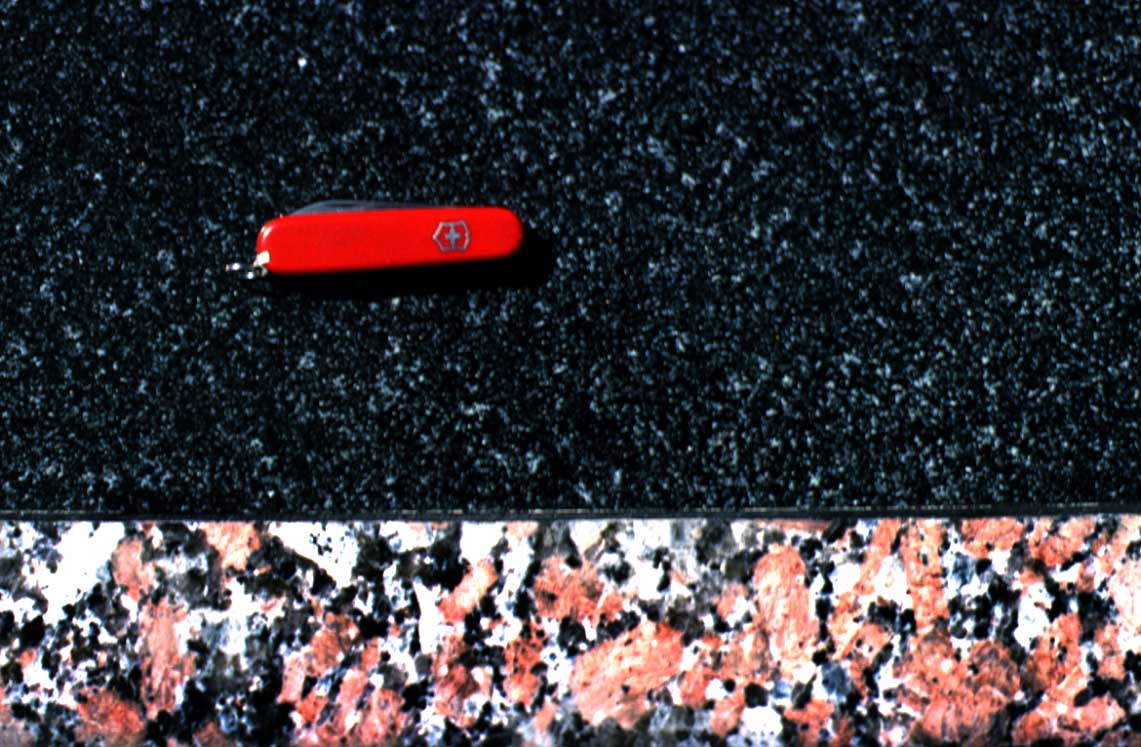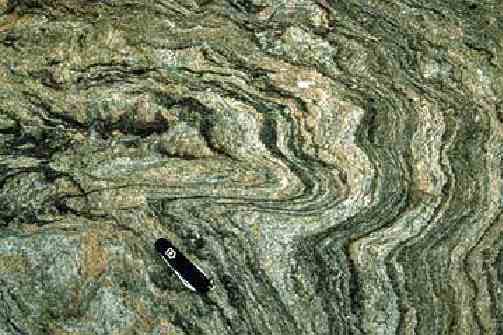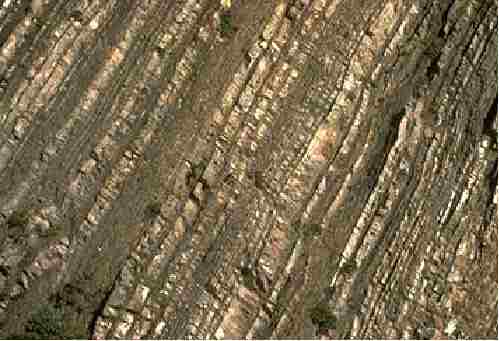
granite (bottom) and gabbro (top) The granite is lighter colored because
it is richer in silica.
Note that both rock types consist of interlocking crystals.
Some important rock types and minerals
All rocks fall into one of three groups: igneous, metamorphic, or sedimentary. Igneous and metamorphic rocks form within the earth at high temperatures. Sedimentary rocks form at the earth's surface. We will spend most of this meeting learning their distinguishing characteristics.
Igneous rocks form by cooling and crystallization from a molten state. Therefore, they consist of interlocking crystals. Intrusive igneous rocks cool and crystallize slowly within the earth and so have coarse grains. Extrusive (volcanic) igneous rocks cool and crystallize rapidly on the earth's surface and so have fine grains. Extrusive rocks frequently contain some larger, well-shaped, crystals surrounding by the fine-grained material.
Igneous rocks are further classified by their chemical composition. The types of minerals in the rock reflect this chemistry. Generally, the richer in silica and oxygen, the lighter colored the rock.

granite (bottom) and gabbro (top) The granite is lighter colored because
it is richer in silica.
Note that both rock types consist of interlocking crystals.
to see other igneous features, click here.
Metamorphic rocks consist of pre-existing (igneous, metamorphic, or sedimentary) rocks that underwent a change because of high temperatures and usually, pressure. With these high temperatures, the original mineral grains react and change into different types. Clay minerals, for example, will transform into micas. Because the metamorphism usually also involves directed pressures, the newly formed minerals grow in a preferred orientation. Consequently, metamorphic rocks have a crystalline texture and usually show a distinctive layering, called foliation.
You can distinguish foliation from bedding by what forms it. Foliation is formed by oriented crystals; bedding is formed by different sized, rounded grains.
Metamorphic rocks are further characterized by their grain size. In general, the coarser the grain size, the higher "grade", or temperature, of metamorphism.

Folded gneiss. Wind River Range, Wyoming.
Sedimentary rocks consist of particles (sediment) worn from pre-existing rocks. They may be clastic sedimentary rocks, where the sediment consists of gravel, sand, silt, clay, chemical sedimentary rocks, where the sediment consists of precipitated materials (eg. salt), or biogenic sedimentary rocks, where the sediment consists of biologically produced material (eg. shell fragments). The sediment accumulates in layers, and through time, becomes glued together through the action of groundwater.
Therefore, sedimentary rocks consist of individual, worn, particles.
Most of these particles are visible with a handlens. At the scale of an
outcrop, you should also be able to see the layering, called "bedding".
Single hand specimens are usually too small to show bedding. The photo
on the far right below, shows bedding--defined by alternating beds of sandstone
and shale.

conglomerate |

sandstone |

interbedded sandstone and shale |
click here to see some other sedimentary features
Some unidentified rocks.
Identify the following rocks as either igneous (note whether intrusive or volcanic), metamorphic, or sedimentary.
Rock 1 _________________
Rock 2 _________________
Rock 3 _________________
Rock 4 _________________
Rock 5 _________________
Minerals
Have a look at the mineral specimens on display. Make sure you
can tell the following ones apart: quartz, feldspar, muscovite, pyroxene,
calcite
Referring to the igneous rocks, in which intrusive igneous rocks can you find the following minerals?
quartz ___________
feldspar __________
muscovite _________
pyroxene __________
In which of the metamorphic rocks do you see the most muscovite?
What mineral is most prevalent in the sandstone?
What mineral is most prevalent in the limestone?
Back to Geology102